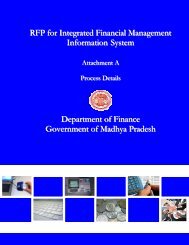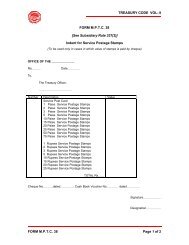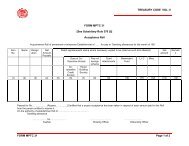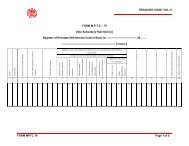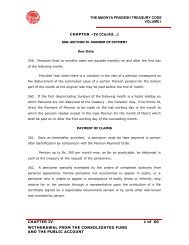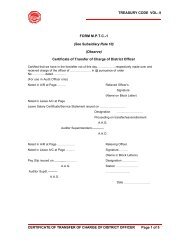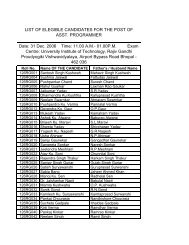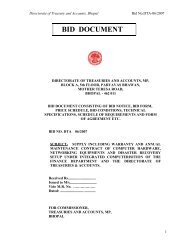THE MADHYA PRADESH TREASURY CODE ... - Mptreasury.org
THE MADHYA PRADESH TREASURY CODE ... - Mptreasury.org
THE MADHYA PRADESH TREASURY CODE ... - Mptreasury.org
You also want an ePaper? Increase the reach of your titles
YUMPU automatically turns print PDFs into web optimized ePapers that Google loves.
<strong>THE</strong> <strong>MADHYA</strong> <strong>PRADESH</strong> <strong>TREASURY</strong> <strong>CODE</strong><br />
VOLUME I<br />
with in transit. He should examine and regulate the procedure of Sub-treasury<br />
Officers as far as he can from the daily examination of their accounts.<br />
CLOSING FOR <strong>THE</strong> DAY<br />
33. Subject to the directions contained in this behalf in the Account Code, Volume<br />
II, the process of closing accounts for the day shall be as follows:-<br />
(a) The daily total of each subsidiary register will be entered in the appropriate<br />
part of the cash book, which will then be totalled, and the balance memorandum at<br />
the top of the Asstt. Treasury Officer's balance sheet will be drawn up strictly in<br />
accordance with the directions contained in the Account Code, Volume-II. To the<br />
account balance thus brought out, the additions and deductions indicated at the foot<br />
of the cash book form will be applied so as to bring out the cash balance at the<br />
district treasury.<br />
(b) Meantime, the Treasurer will also sum both sides of his cash book and draw up<br />
his balance memorandum in the form of the Treasurer's daily balance sheet (Form M.<br />
P. T. C. 4).<br />
(c) If the results shown in the two balance sheets agree, the treasury Officer<br />
should sign the two cash books and the two balance sheets. He should first satisfy<br />
himself of the correctness and good order of all these documents and should give<br />
special attention to the reconcilement of the account balance of the district with that<br />
actually in the headquarters treasury; the latter excludes the balance in subtreasuries<br />
or under remittance within the district, which the former includes.<br />
(e) The following is memorandum of some of the more important parts of the<br />
verification. The Treasury Officer should---<br />
(i) compare each entry of payment in a register with the payment order,<br />
ticking off each voucher as it is passed. This will not be necessary if the Treasury<br />
Officer adopts the alternative plan of having the account entry presented to him for<br />
initials at the same time that he signs the order of payment;<br />
(ii) examine at least two of the totalling on each side, marking the totals as<br />
"Exd".<br />
(iii) see that the totallings are correctly carried from the register to cash<br />
book, initialling the totals as he thus compares them;<br />
Note--This must done, in the case of receipt registers, even when the total for the<br />
day is blank; but it is not necessary to initial blank payment registers. If the<br />
number of blank receipt registers is great, the following plan may be adopted.<br />
Such registers as are only rarely required for entry may be bound in a single<br />
volume and kept under the Treasury Officer's own lock. When the volume is<br />
required for entry, he should give out the register for the purpose, and he<br />
should receive it back at the time of signing the daily accounts, carefully<br />
seeing in doing so that all new entries in it are correctly carried to the cash<br />
book and initialling them accordingly. It is, obviously necessary to guard<br />
CHAPTER I 10 of 25<br />
GENERAL ORGANISATION AND WORKING OF TREASURIES


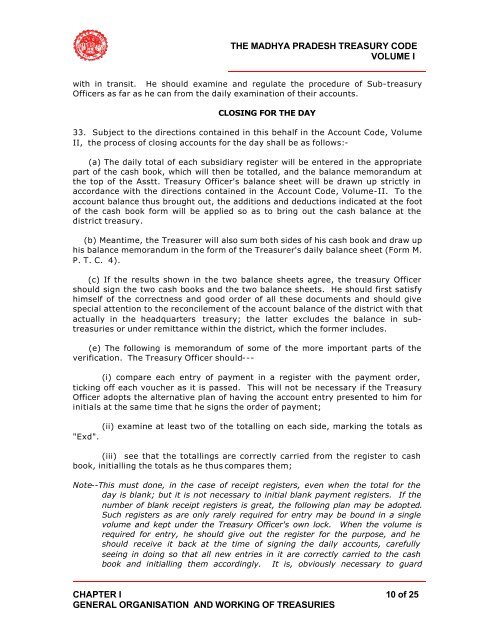
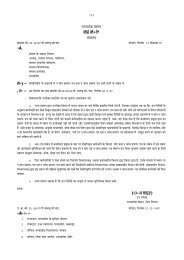
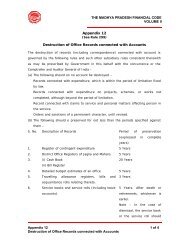
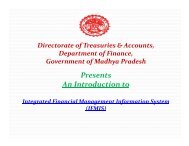
![Form M.P.F.C. 20 [See Rule 266 (4)] - Mptreasury.org](https://img.yumpu.com/50367893/1/190x146/form-mpfc-20-see-rule-266-4-mptreasuryorg.jpg?quality=85)

